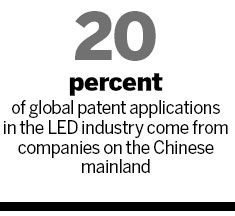Though LED lighting technology is among the fastest-growing industries in the world today, prospects for domestic manufacturers in the world market remain dim due to a lack of core patents and technologies, according to GG-LED, a professional LED news website.
Currently, the United States, East Asia and Western Europe are the three pillars of the international LED industry. Markets for high-end products are occupied by a few international giants, which lead in terms of both patent quantity and quality.
In terms of patent ownership and market share, the leading global LED manufacturers and suppliers include Japan's Nichia, Dutch electronics giant Philips and Seoul Semiconductor based in South Korea, said Zhang Zhicheng, deputy director of the protection and coordination department at the State Intellectual Property Office, in an interview with the news website.
And, two other Japanese brands, Toshiba and Sharp, can be considered excellent technology vendors, he said. He emphasized that none of the leading brands is a Chinese company.
"Most domestic LED makers have potential, but they are still in the initial stage. They are facing a high probability that they will be involved in international intellectual property disputes just like emerging companies in other industries."
Their inadequate patent inventory has made the situation even grimmer, Zhang said.

According to the report, mainland Chinese companies account for one-fifth of global patent applications in the LED industry, yet most of them are filings for utility models and design patents, while the industry's upstream patents, such as those for chip manufacturing, are scarce.
"Patents have become an effective weapon for foreign industrial giants to safeguard the current industrial pattern, which will be gradually solidified as the technology gets improved and eventually matures," said Zhang.
"If patent cross-licensing and alliance construction are finished in major LED technical fields, it will be a huge challenge for Chinese LED companies to enter the core areas, leaving them only engaged in the external and downstream sectors of the industrial chain."
From 2008 to 2012, Chinese LED companies repeatedly got involved in IP disputes, lawsuits and US Section 337 investigations covering diverse aspects of the industry chain.
"A patent dispute is a war without gun smoke, and many times, we have infringed the IP rights of others unconsciously," said Liang Bingwen, a researcher at the Suzhou Institute of Nano-Tech and Nano-Bionics under Chinese Academy of Sciences.
"With the rapid development of the domestic LED lighting industry, more related tort actions will begin to appear."
He noted that although reconciliation is the outcome of most of the litigations, defendants must have some persuasive patents or reconciliation can be very difficult to reach.
Therefore, Chinese LED manufacturers should focus more on innovation and increase investments, said You Tao, a senior IP officer at the National Software and Integrated Circuit Public Service Platform.
They could introduce some advanced foreign patented technologies, or jointly get the patent authorization, he said.
Moreover, companies could map out the patent strategies in a certain technical aspect based on their advantages, he noted.
haonan@chinadaily.com.cn
(China Daily 03/27/2013 page17)

